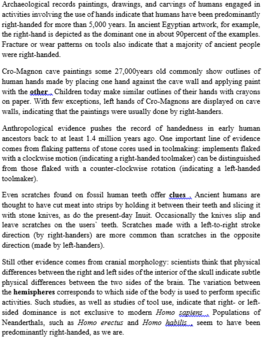Read the following passage and mark the letter A, B, C or D on your answer sheet to indicate the correct answer to each of the questions from 36 to 42.
Although speech is the most advanced form of communication, there are many ways of communicating without using speech. Signals, signs, symbols and gestures may be found in every known culture. The basic function of a signal is to impinge upon the environment in such a way that it attracts attention, as, for example, the dots and dashes of telegraph circuit. Coded to refer to speech, the potential for communication is very great. Less adaptable to the codification of words, signs also contain meaning in and of themselves. A stop sign or a barber pole conveys meaning quickly and conveniently.
Symbols are more difficult to describe than either signals or signs because of their intricate relationship with the receiver's cultural perceptions. In some cultures, applauding in a theater provides performers with an auditory symbol of approval. Gestures such as waving and handshaking also communicate certain cultural messages.
Although signals, signs, symbols and gestures are very useful, they do have a major disadvantage. They usually do not allow ideas to be shared without the sender being directly adjacent to the receiver. Without an exchange of ideas, interaction come to a halt. As a result, means of communication intended to be used for long distances and extended periods must be based upon speech. To radio, television and the telephone, one must add fax, paging systems, electronic mail, and the Internet, and no doubts but that there are more means of communication on the horizon.
Why were the telephone, radio, and television invented?
A. Because people wanted to communicate across long distances.
B. Because people wanted new forms of communication.
C. Because people were unable to understand signs, signals, and symbols.
D. Because people believed that signs, signals, and symbols were obsolete.





Kiến thức: Đọc hiểu
Giải thích:
Tại sao điện thoại, radio và truyền hình được phát minh?
A. Bởi vì mọi người muốn giao tiếp qua một khoảng cách dài.
B. Bởi vì mọi người muốn các hình thức giao tiếp mới.
C. Bởi vì mọi người không thể hiểu được dấu hiệu, tín hiệu và biểu tượng.
D. Bởi vì mọi người tin rằng dấu hiệu, tín hiệu và biểu tượng đã lỗi thời.
Dẫn chứng: As a result, means of communication intended to be used for long distances and extended periods must be based upon speech. To radio, television and the telephone, one must add fax, paging systems, electronic mail, and the Internet, and no doubts but that there are more means of communication on the horizon.
Tạm dịch: Kết quả là, phương tiện giao tiếp dự định được sử dụng cho khoảng cách dài và thời gian kéo dài phải dựa trên lời nói. Đối với phát thanh, truyền hình và điện thoại, người ta phải thêm fax, hệ thống phân trang, thư điện tử, và Internet, và không có nghi ngờ nhưng có nhiều phương tiện giao tiếp sẽ sớm xuất hiện.
Đáp án: A